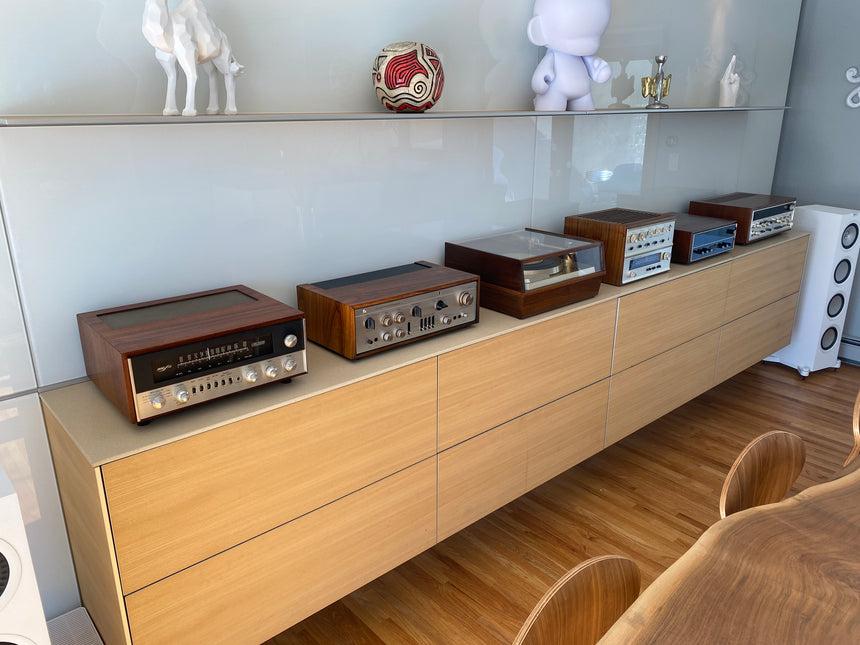Choosing the Right Equipment
If you’re just getting into vintage HiFi, it can be tricky to figure out exactly what you need to get started. Fundamentally, you need a music source, a way to amplify the signal from your source, and a way to convert that signal to sound. Once you get your head around the parts involved, setting up a stereo will start to seem about as easy as plugging in a lamp.
Consider your Room
Of course, budget is going to be a concern, but one of the most avoidable mistakes beginners make is in not fully considering the space and how they listen. Over the years, we’ve helped folks create solutions in spaces as large as a lounge, and more recently, smaller spaces like home offices. One thing that people don’t immediately realize is that sound waves have a fairly long wavelength. Our “inside voice” has a wave longer than a meter, at about 250Hz. Lower frequencies are even longer – the 808 drum hits around 50Hz, which is a nearly 7-meter wave, which is hard to properly reproduce in smaller rooms without thee right acoustic treatment. The rule of thumb here is that “bass needs space,” and that’s one reason why smaller speakers work better in smaller spaces.
If your goal is to get as close as possible to perfect reproduction, focus on headphones. On the other hand, if you’re more interested in filling a room, and sharing the sound, speaker placement can play a big role. Higher frequencies are more directional, so position the tweeters at eye level from the listening position. The sound waves radiate outwards like ripples in a puddle, so you want to avoid anything that will get in the way of those waves, or “shadow” the sound. At the same time, be conscious of where those ripples might bounce off of things in your room on their way to your ears. Because every combination of room and speaker is going to be different, the more room you have to experiment with placement, the better. Generally speaking, the best placement is usually about a foot or two out, along the longest wall in the room. The ideal scenario is usually a perfect triangle between the speakers and the listener. You also want to make sure to give your speakers a proper connection to the floor, to reduce vibrations. They may be called "Bookshelf" speakers, but we don't recommend it.
So how much space do you have now? You've probably visualized where your speakers could go, what about your gear? If you’re thinking about putting your new stereo on (on in) existing furniture in the room, remember vintage gear gets hot, and it will need good airflow. Heat is one of the leading causes of equipment failure, so protect your investment.
Finally, the quiet part out loud: there is no shame in being drawn to a piece simply because you find it beautiful. Anyone who knows us could tell you, we think aesthetics are a huge factor. We’re not here to sell stereo gear – we’re here to share our passion and experience. Anything in your home you don’t find useful or beautiful is simply clutter. We believe that your stereo system should bring you joy in every way, and it should “fit” not just your room, but your aesthetics.
Consider your Source
How do you typically listen to music currently? It’s less about what you listen to than how. The type of music you listen to becomes more of a concern as your audiophile journey progresses. But at this stage of the game, if your new system doesn’t support your typical listening habits, are you really going to use it? You may be hoping to get into vinyl (trust us, we understand), but it’s really important to build your system around the ways you currently listen. Most of us today subscribe to at least one streaming service – if that’s true for you, you’ll want to start with some type of streaming server, and we really like the Sonos products like Port and Connect, which are a very convenient way to send music to your system from your phone. There are some bluetooth products on the market, but WiFi-based gear like Sonos just works better for us. Your mileage may vary.
If you have a collection of physical media, like vinyl, CDs, or tape, but you don’t have a way to play them, you’ll definitely want to consider a playback unit as part of your overall plan. Just don’t build your first system around a component that’s new to you. Build from the ways you’re already listening.
Crank it Up
As we mentioned earlier, you’ll need to amplify the signal from your source before you send it to your speakers (or your headphones). Depending on the additional features, the components you need can go by a few different names. A plain vanilla amplifier will usually have a single input on the back, and speaker terminals. That’s it, maybe a power switch on the front. For volume control and source selection, you’d need another component called a pre-amplifier. An amplifier with those controls built in is called an “integrated amplifier.” An integrated amplifier that can also receive radio signals is called a “receiver.” If part of your goal is to have as few components as possible, start with a receiver or an integrated amp, to keep your setup simple.
Grow Slowly
Music is a bigger part of our lives than a lot of us realize, so if you’re planning to take it to the next level, don’t let go of your current listening patterns and methods – build on them. Whether you typically use a streaming service or satellite radio, plan your system around that. Get a good sense of what you can do in the room, both sonically and aesthetically, which will help you select the right speakers. The speakers you choose will help narrow down your options for powering them. Just like anything that seems overwhelming, once you break it down and understand the steps, getting into vintage HiFi can be really enjoyable. We like to think that’s why we’re here, so let us know if you have any questions!


